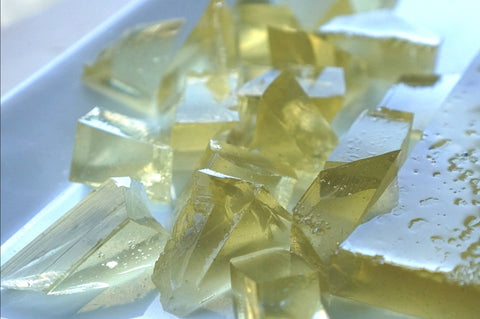Kohakuto (琥珀糖) literally means amber sugar. It is a Japanese traditional candy, and has been made for about 400 years since the early Edo Period. It is good for tea time , and it is often served as a part of the tea ceremony.

The texture is unique. It has a crunchy shell on the outside and a jelly texture on the inside. Crystallized sugar makes the crunchy shell on the outside. What makes the jelly texture on the inside? It is Kanten.
What is Kanten (寒天)?
Kanten is gelatinous substance, made from algae. Agar might come to your mind. Yes, Kanten is very similar to agar. But, as they are made from different algae, we consider agar and Kanten different ingredients. Their textures and the ways of using are slightly different. It is however possible to use agar for this recipe, but the result may not be the same. Alright, let's get started!
TEA FLAVORED KOHAKUTO RECIPE お茶の琥珀糖レシピ
INGREDIENTS
[ For 20cm x 18cm / 8 in. x 7 in. container ]
Hojicha tea leaves 6g / 6 heaping tsp
Hot water 200ml
Powdered Kanten 4g / 0.15oz *1
Granulated sugar 300g / 10oz *2
*1 Agar is possible to use ,but results may not be the same.
*2 Caster sugar is possible to use ,but granulated sugar would make the taste smoother and look nicer.
INSTRUCTIONS
1. Steep the tea in a pot. ( 5g of tea leaves, 200ml of hot water, 2-3minutes ) Making the tea stronger and bitterer than usual is good for this recipe.
2. In a pan, pour the tea liquid and place on stove over low-medium heat. Sprinkle the Kanten over the liquid and mix well to dissolve.

3. Simmer for 1-2 minutes on low heat stirring constantly.
4. Add the sugar into the pan and mix constantly on low heat until the sugar dissolves.

5. Take the mixture off the heat.
6. Pour the mixture into a container. Put the container into the fridge and let it chill for 1-2 hours until set.

7. Pull the mixture out of the container and cut it into uneven pieces. I teared it.

8. Place the pieces onto a parchment sheet and let them dry at room temperature for 1-2 weeks until they get a crystal skin on the outside.

Done!! You can store them in an air tight container at room temperature for about 3-4 weeks.

Different ways of cutting
Use a sharpen knife to cut into uneven pieces.

It will be fun to cut into shapes !

It makes a good present.

Enjoy making and eating Kohakuto!
How to make MATCHA flavored Kohakuto
1. Use a half spoon of Matcha instead of Hojicha tea leaves. Mix well with 200ml of hot water.
2. Follow the Instruction 2-8.
You can use any types of tea. I tried making Kohakuto with few different flavors of tea, then I chose Hojicha roasted green tea for this recipe as I feel Hojicha add a nice flavor to Kohakuto.

Today's recommendation
Hojicha Tea Leaves
Shop Hachimanjyu: Organic Yakushima Hojicha Roasted Green Tea
It has a sweet roasted nutty flavor and slightly astringent aftertaste as it is a light roasted type of Hojicha. The flavor goes well with Kohakuto.
Matcha
Shop Yunomi Matcha: Premium Culinary Grade Matcha
Also known as a latte grade or cafe grade, this matcha is meant for use in making matcha lattes, chocolates, ice cream, and baked goods such as cakes, frosting, cookies, etc.
- Region: We source from Kagoshima, Kyoto, Nishio, Mie, and Shizuoka, Japan.
- Notes: All tea leaves are used were grown without pesticides but were not necessarily certified as organic
- Color: Dull but dark green.
- Texture: Ultra fine. (A very low grade matcha would taste grainy.)
- Aroma: Weak
- Flavor: Strong. Good balance of umami / astringency.





